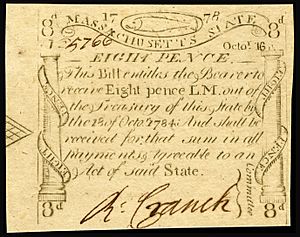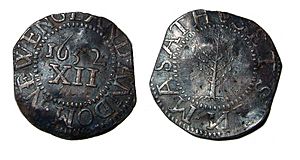Massachusetts pound facts for kids

The Massachusetts pound was the money used in Massachusetts. It was used when Massachusetts was a colony and after it became a state. People used it until 1793.
This money system was called £sd. One pound was worth 20 shillings. Each shilling was worth 12 pence. At first, people used British money (called sterling) and money from other countries. Later, Massachusetts made its own coins, like the the pine tree shilling. They also printed local paper money starting in 1690.
The paper money printed in colonial Massachusetts was also in pounds, shillings, and pence. But it was worth less than British sterling money. For a while, six shillings were equal to one Spanish dollar. After many years of prices going up (inflation), Massachusetts stopped using its paper money in 1749. They went back to using metal coins.
Massachusetts started printing paper money again in 1775. This was when the American Revolutionary War began. The state's money lost a lot of its value. In 1793, the U.S. dollar replaced the Massachusetts pound.
Coins of Massachusetts

Massachusetts made shillings in different values. These included 3 pence, 6 pence, and 1 shilling. The very first coins had the letters "NE" and their value, like "III" or "XII". These coins, known as the pine tree shillings, were a bit smaller than British coins of the same value.
Later coins, made between 1652 and 1660, showed a willow tree. Then, coins made until about 1667 had an oak tree. But the most famous design was the pine tree. These coins were made from about 1667 to 1682. They were used widely across North America and the Caribbean.
Almost all these shillings had the date "1652" on them. This was the year the Massachusetts Bay Colony allowed shillings to be made. The people making the coins kept this date. They did this to seem like they were following English law. In 1652, England was a Commonwealth, not ruled by a king. Only the king was supposed to make shillings.
John Hull and Robert Sanderson, two settlers in Massachusetts, made these shillings. The pine tree on the coins might show how important pine trees were to Massachusetts. They were a big export, used for ships' masts. The "Hull Mint" that made these coins was closed by the English government in 1682.
Paper Money in Massachusetts

Paper money started being printed in 1690. These notes were also valued in pounds, shillings, and pence. They were printed from special copper plates. A silversmith named Jeremiah Dummer likely made these plates.
The first paper money lost value compared to silver coins. So, in 1704, new "Old Tenor" notes were introduced. One Massachusetts shilling was still worth 9 pence sterling. But these notes also lost value over time.
Later, different types of notes were introduced. These included "Middle Tenor" in 1737 and "New Tenor" in 1741. They were worth more than the "Old Tenor" notes. Finally, in 1759, all older notes were replaced by the "Colonial" issue. These were worth 10 times the original "Old Tenor" notes.

